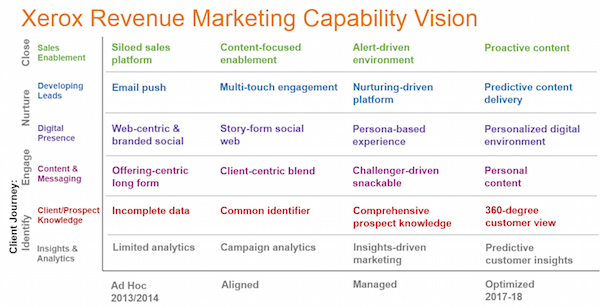I’m incredibly excited to share with you the following Q&A with Bala Kudaravalli, a leading marketing technologist at Symantec. (With thanks to Scott Vaughan at Integrate for introducing us!)
With Symantec’s permission, Bala was able to share some very helpful details about the marketing technology transformation effort that they have underway at the company — and the cross-departmental governance structure that they’re using to manage it.
Given Symantec’s size, the scale and scope of this global initiative is massive. And Bala provides some incredible insight into how they’re making it happen.
Tell us a little about your background and your current role at Symantec.
I started my career about 16 years ago teaching Java. Since then, I’ve had numerous roles in IT — system admin, programmer, team lead, manager, and architect. Along the way, I spent a couple of years as a technology consultant honing my analytical, communications, and negotiating skills. I supplemented my undergraduate computer engineering degree with an MBA in Strategy & Marketing.
In my current role as a marketing technologist at Symantec, I own the creation and execution of the marketing technology strategy that will enable personalized customer journeys across multiple channels for our global B2B & B2C customers.
In this role I see myself as an evangelist, an influencer, and a negotiator.
An evangelist because I’m introducing marketers to what is possible with new technology, have them try out new innovations, and get them to buy-in to the overall vision of leveraging technology as a competitive differentiator. An influencer because I need to gain the trust of those marketers, exhibit a high degree of subject matter expertise, and share experiences on how adopting new technologies can shape their roles and help them become more effective. A negotiator because I have to come up with viable solutions that work for multiple stakeholders, whose priorities and interests might not always be aligned.
As a marketing technologist, I see myself as an evangelist, an influencer, and a negotiator.
When you took on this current role, what did the marketing technology environment at Symantec look like? What was the vision for where it should go? How does a marketing technologist go about developing a vision?
Siloed and fragmented would be the best way to sum up the environment. The technologies available to marketers were rudimentary, antiquated, and complex — limiting the ways in which marketers could reach prospects and customers. Each line of business had its own technology stack, which evolved based on their needs rather than by a cohesive plan.
Our marketing technology transformation vision is to equip marketers with data and applications that can be used to improve customer journeys — to gain trust, build relationships, and develop lifelong customers, while simplifying the tech stack and becoming operationally efficient.
Our marketing technology vision is to equip marketers to improve customer journeys while becoming operationally efficient.
Creating the vision was a collaborative effort between marketing, sales & marketing operations, and IT. The framework I used was a simple: Observe, Research, Draft, Solicit Input, and Update:
- Observe — Learn the various ways in which marketers currently interact with prospects and customers and why they choose to interact in those ways.
- Research — Familiarize with the paradigm shift in customer behavior in the last couple of years towards marketing activities — the blurring of lines between B2B and B2C marketing and the expectation for companies to know their customers’ and prospects’ recent interactions and suggest reasonable personal recommendations.
- Draft — Using the above data points, reflect upon past experiences and existing processes and systems to draft a vision that can be realized in 18-24 months. Given the rate of change in technology, I believe this is a reasonable time frame for a roadmap.
- Solicit Input — Socialize the draft, gather feedback from stakeholders, and iterate. It is very important to get agreement and buy-in from the cross-functional team at this stage.
- Update — Publish the vision and keep evangelizing it; the vision serves a guide post for where we want to be as we mature into a more modern marketing organization.
Can you describe, at least at a high level, the architecture of the marketing technology stack you’re building?
My objective is to build an agile stack that can grow and adapt to changing market demands. At a high level, the stack consists of a data platform, core applications, and innovative applications.
My objective is to build an agile stack that can grow and adapt to changing market demands.
Data Platform — We believe that data is the foundational component of all marketing activities. Given that our universe of B2B and B2C customers and prospects is in the hundred of millions of records, this is quite a challenge. We are creating a platform that will serve as a single source of truth for all marketing customer and contact data. Data quality, augmentation (3rd party), and standardization services will be integral to the platform. Data visualization, predictive modeling, and segmentation tools will also be available.
Core Applications — These are foundational applications that drive the majority of marketing activities. Collectively, they provide differentiation for how our marketers can reach prospects and customers. They include a multi-channel campaign management system, a content marketing system, a social listening and publishing platform, MRM, and web analytics tools.
Innovative Applications — Applications spun up quickly to support innovation and experimentation with new ideas fall in this category. Social data visualization, social selling, personalization, and media partner management tools are a few that have potential to be part of our stack.
Who are the stakeholders in the evolution of the company’s marketing technology? What governance mechanisms are there to keep everyone aligned?
The marketing, sales & marketing operations, and IT teams are the stakeholders. We are currently in the implementation phase. To ensure alignment, we work with a steering committee, the core team, and a global extended core team.
The steering committee meets bi-weekly, and its charter is to review progress and make critical decisions regarding scope, budget, and prioritization. It consists of a cross-functional team of executives and also includes representation from one of our primary external implementation partners.
The core team meets weekly. It is a larger cross-functional team responsible for day-to-day implementation. Each core team member owns a track and is responsible for the implementation and roll-out — e.g., data, trialware, preference center, sales & marketing alignment, etc. The change manger is a key role on the core team and is responsible for ensuring alignment on what to roll-out when. Members of the core team work out of a war room, and they are all in sync on everything going on in this initiative.
The change manager is a key role on the core team and is responsible for ensuring alignment on what to roll-out when.
The extended core team comprises of regional representatives. This global team is responsible for roll-out of technologies in their regions. The core team meets with the extended core every week to review the past week’s accomplishments and this week’s tasks and discuss topics that need attention.
The result of the above structure is a highly collaborative cross-functional team with clear ownership and accountability.
Related to that, where does the money come from? How much of this work is paid from IT’s budget vs. marketing’s budget? What’s the rationale for that decision?
Technology decisions are made jointly by a cross-functional team, and most of the spend comes from the IT budget. This ensures that we keep tabs on technology proliferation and compliance with regulations and policies. A lean “Marketing IT” team provides technical support for the marketing technology stack.
As you’re rolling new technology, how do you help the broader marketing team adopt it and take full advantage of its capabilities?
Great question. Our first implementation in the technology transformation initiative is the roll-out of a marketing automation system. When we signed the contract, we made a conscious decision to invest in professional services and employee training and certifications with the selected partner.
The partner’s professional services team was engaged to help us align on common processes, educate us on the best practices for a global roll-out, and help configure the base system with the agreed new processes.
We invested in live training and certifications for key employees across all regions. We also identified a change manager within marketing and paired him up with a change coach from the partner. A global change network led by the extended core team was established to ensure that we clearly communicated and managed the implementation to identify and mitigate issues early on. Additionally, we worked with our partner to provide on-site office hours in regions with technical advisors.
Finally, the core team is regularly briefing multiple groups and individuals to evangelize the program and technology stack. We are on a journey, and our executives are committed to providing access to the resources required to drive adoption and be successful.
How do you define “success” in this role? What is your biggest obstacle or challenge to success?
I consider the role a success if I am able to create a common vision, gain alignment across all stakeholders, and deliver data-driven and technology-driven solutions that make a material contribution to the business.
I believe that getting buy-in from front-line marketers is key to the success of this role. Adoption of technologies by marketers helps measure success of tech strategy. Securing funding for the execution of a technology strategy is a close second. Strategy without execution is purely an academic exercise without tangible outcomes.
I believe that getting buy-in from front-line marketers is key to the success of this role. Securing funding is a close second.
What advice would you give to someone just starting their career who wanted to become a leader in this kind of work?
This is a very broad field of work, and depending on the background, there are many routes you could take to become a marketing technologist. Here are a few key skills that I believe will help:
- Cultivate an affinity for technology — think possibility and limitations
- Learn to connect the dots when there is lack of structure — think of why and what
- Develop influencing and negotiation skills
- Hone your presentation skills
- Acquire experience with marketing processes and general business acumen
- Be curious and jump in
Thank you, Bala! I particularly love that most of your recommendations are to encourage marketing technologists to develop leadership skills that transcend technology. Well said!




Scott,
This one too is an awesome article, second interview in a week.
For me the important aspect of this interview are the following two points:
1) As a marketing technologist, I see myself as an evangelist, an influencer, and a negotiator.
2) I believe that getting buy-in from front-line marketers is key to the success of this role. Securing funding is a close second.
I have read so many articles and seen so many discussions but I have not seen until this interview someone talking about these 2 points in detail. These are the 2 top most points from my perspective. Chief Marketing Technologist role is beyond just a bridge between Marketing and Technology. To the first point I will add 2 more words from my perspective (large B2B); strategist, collaborator.
Chief Marketing Technologist is an strategist, evangelist, influencer, negotiator and collaborator.
On the second point, I can agree no more that before you try to propose the change at the executive level, it is very important to get all the buy-in at the execution layer.
I will reiterate your thanks to Bala in the end around skills recommendation.
Thanks to your awesome vision, leadership and more importantly your commitment with all the efforts you are putting into the evolution of the role of marketing technologist.
I look forward for your next interview, sometime this week 🙂
Thanks, Rohit. I agree — Bala makes a really excellent point about the importance the CMT role has with front-line adoption in the broader marketing team. Glad it resonated with you!